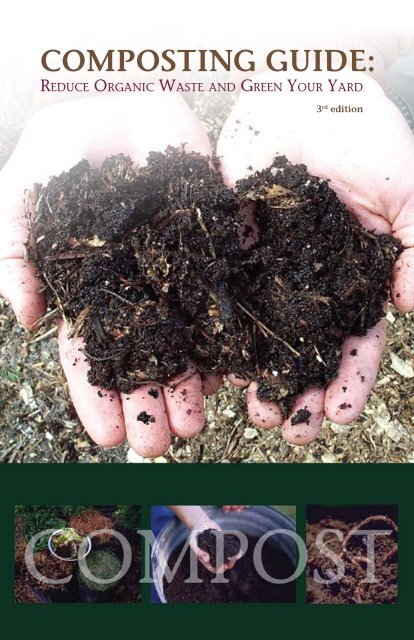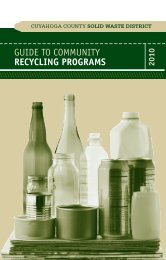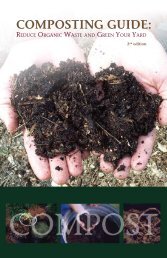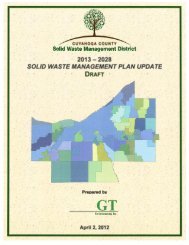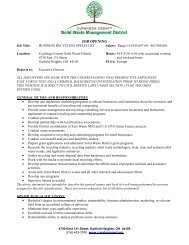Composting guide: - Cuyahoga County Solid Waste District
Composting guide: - Cuyahoga County Solid Waste District
Composting guide: - Cuyahoga County Solid Waste District
You also want an ePaper? Increase the reach of your titles
YUMPU automatically turns print PDFs into web optimized ePapers that Google loves.
<strong>Composting</strong> Guide:<br />
Re d u c e Or g a n i c Wa s t e a n d Green Yo u r Ya r d<br />
3 rd edition
COMPOST<br />
Table of Contents<br />
Why Compost, Supplies Needed ............. 1<br />
Compost Bins ............................ 2<br />
Buy, Build. .............................. 2<br />
Size, Placement .......................... 2<br />
Start A Compost Pile ...................... 3<br />
Maintaining a Compost Pile ................ 4<br />
How to Produce Optimal Compost Conditions .. 4<br />
Problem Solving. ......................... 5<br />
Compost Dos and Don’ts ................... 5<br />
Using Finished Compost ................... 6<br />
Other <strong>Composting</strong> Methods ................ 7<br />
Compost Benefits ......................... 8<br />
Compost Resources ....................... 8<br />
If you already compost in your backyard,<br />
please add yourself to the compost survey list<br />
by emailing swdinfo@cuyahogacounty.us.<br />
Answering the survey will give a recycling<br />
credit to your city.
Compost is<br />
• A dark, crumbly soil amendment.<br />
• A waste reduction strategy for yard and<br />
food waste.<br />
• Nature’s way of recycling.<br />
• Natural mulch.<br />
• Nutrient rich.<br />
• A simple way to prevent methane gas<br />
production.<br />
WHY COMPOST<br />
<strong>Composting</strong> is a great way to keep organic<br />
material out of landfills. It is a good<br />
environmental practice, and an inexpensive<br />
way of adding nutrients back into the<br />
soil. Applying compost to soil improves its<br />
texture, structure, aeration ability and water<br />
holding capacity. It adds-up to improved soil<br />
fertility and root development. Trees, flowers<br />
or vegetables will grow healthier with less<br />
chemicals or fertilizers.<br />
Supplies NEEDED<br />
• Compost bin or outdoor area to compost.<br />
• Shovel.<br />
• Aeration tool such as a pitch fork or compost<br />
aerator.<br />
• Kitchen food scrap holding pail.<br />
• Thermometer.<br />
• Organic material such as yard waste, food<br />
scraps and shredded paper.<br />
• A compost activator or accelerator including<br />
urea, manure, or bone meal to help the<br />
compost process start quickly and efficiently.<br />
<strong>Composting</strong> Guide 1
Compost BinS<br />
Bu y<br />
The <strong>Solid</strong> <strong>Waste</strong> <strong>District</strong> is selling<br />
affordable bins during its “Compost<br />
Seminars and Bin Sales.” Log onto www.<br />
cuyahogaswd.org to find out seminar<br />
dates and locations. The Wishing Well<br />
Composter, Ultimate Dirt Machine<br />
Digester and Sure-Close pail will be sold<br />
during these events. If you can’t wait<br />
for the next scheduled event, then you<br />
can buy a bin directly from the <strong>District</strong>.<br />
Facility hours are Monday through Friday<br />
from 8:30 a.m to 4:30 p.m.<br />
Many garden, hardware stores and<br />
warehouse clubs carry compost bins<br />
seasonally. You can also find them online<br />
at www.planetnatural.com and www.<br />
cleanairgardening.com. Brand names<br />
include Earth Machine, Tumbleweed,<br />
EnviroCycle, Sun-Mar, ComposTumbler,<br />
Earth Engine, Prestro Hoop and Garden<br />
Gourmet.<br />
We recommend bins that sit on the<br />
ground, but consider a rolling compost<br />
bin for more flexibility in placement,<br />
i.e. close to the house or in the garage.<br />
These bins are more expensive, but easily<br />
add oxygen to the pile. Also, small scale<br />
composting can be done indoors by either<br />
buying a kitchen composter or making<br />
one out a plastic container.<br />
If you are a member of garden club<br />
or other organization, please consider<br />
hosting a <strong>Composting</strong> Seminar and Bin<br />
Sale. Call for details at 216-443-3731.<br />
-Or-<br />
Pi l e Si z e<br />
An effective compost pile must be large<br />
enough to hold the heat in the center<br />
while still allowing air to permeate the<br />
pile. When creating a pile, maintain the<br />
size between 3’ x 3’ x 3’ to no larger than<br />
5’ x 5 x 5’. Adding the same volume<br />
of materials to a purchased bin will<br />
optimize decomposition.<br />
Pl a c e m e n t<br />
• Look for a level, well-drained area.<br />
• Keep it accessible from all sides.<br />
• Keep the pile or bin in a sunny spot to<br />
trap solar heat. The compost may need<br />
water in the summer.<br />
• Shelter it near a building or<br />
landscaping that blocks wind to protect<br />
the compost pile from freezing winds.<br />
• Build a pile over permeable soil or<br />
lawn.<br />
• Look for a spot that allows you to<br />
compost discretely, especially if you have<br />
neighboring yards close by.<br />
Bu i l d<br />
Compost piles can be contained in<br />
chicken wire, bricks or wood pallets.<br />
Follow the proper pile size when building.<br />
The least expensive method is just<br />
creating a pile.<br />
2 <strong>Composting</strong> Guide
Start A Compost Pile<br />
1. Place 4”- 6” of base material such as chopped<br />
brush, twigs or wood chips on the ground.<br />
This will allow air circulation around the base<br />
of pile. (Skip this step if using a compost mixing<br />
container).<br />
2. Alternate a 2”- 4” layer of green organic<br />
material containing nitrogen and 4”- 6” of<br />
brown organic material containing carbon.<br />
Keep a ratio of 1-part green and 2 to 3 parts<br />
brown. Do not compact layers to allow for air<br />
circulation.<br />
3. After each green and brown layer, add up<br />
to 1” of an activator (aged compost or garden<br />
soil) to introduce microorganisms into the pile.<br />
Activators such as manure, bone meal or urea<br />
fertilizer provide nitrogen to encourage the<br />
reproduction of microorganisms.<br />
4. Water the pile, so it’s moist, but not soaking wet.<br />
Pile Composition<br />
25-50% green or nitrogen<br />
containing organic matter<br />
Vegetables, fruits, flowers, plant<br />
clippings, grass clippings, coffee<br />
grinds, manure, etc.<br />
Essential Elements<br />
of A Compost Pile<br />
Organic<br />
material<br />
Oxygen<br />
Water<br />
Compost Creatures -<br />
microorganisms<br />
50-75% brown or carbon<br />
based organic matter<br />
Dead leaves, straw, sawdust,<br />
wood chips, shredded<br />
newspaper, corn stalks, cotton<br />
rags, nut shells, pine needles,<br />
etc.<br />
The correct mixture affects<br />
quality of the compost and<br />
the speed of decomposition.<br />
Another method is comparing<br />
C:N ratios of organic material.<br />
The optimal ratio is 30:1. Ratios<br />
of common organic material can<br />
be researched online.<br />
<strong>Composting</strong> Guide 3
Maintaining a Compost Pile<br />
The instructions below will help you create compost within six months. <strong>Composting</strong><br />
is like a science experiment; it needs to be observed and adjustments made.<br />
Co m p o s t c r e at u r e s:<br />
• Micro-organisms.<br />
• Bacteria and fungi.<br />
• Macro organisms.<br />
• Insects and arthropods like worms, centipedes, sow bugs, beetles, snails or slugs.<br />
An initial source of compost creatures can be added through garden soil or aged<br />
compost. Also, the pile should be maintained to provide them appropriate food,<br />
water and oxygen. The creatures will help decompose the organics faster.<br />
Mo i s t u r e<br />
The compost should have 50% moisture content and feel damp like a wrung-out<br />
sponge. Water can be added to the compost pile by either adding green material or<br />
sprinkling the pile with water.<br />
Ox y g e n<br />
The pile should be aerated about once a week by.<br />
• Turning the pile outside to inside or top to bottom.<br />
• Stirring the pile.<br />
• Using an air stack or aerator tool to bring air into the center of the pile.<br />
• Rotating a tumbler compost bin every two to three days.<br />
Su r f a c e Ar e a<br />
Increase the surface area by shredding or cutting organic material into smaller pieces.<br />
Pr o p e r s i z e<br />
Keep the volume around 3 cubic feet.<br />
Pr o p e r Te m p e r at u r e<br />
Most backyard compost piles only reach 90° – 120°. If you do not keep a consistent<br />
aeration schedule, then turn the pile when the temperature peaks. If the pile no<br />
longer heats up, it may be an indication that the compost is ready for application.<br />
Hint: If you’re<br />
consistently adding<br />
kitchen scraps to your<br />
compost pile, then keep<br />
a source of carbon next<br />
to your compost bin to<br />
maintain the proper ratio.<br />
4 <strong>Composting</strong> Guide
Problem Solving<br />
• To help dry an over watered pile, add sawdust, straw or wood chips or place wood<br />
planks underneath the pile to ensure good drainage.<br />
• When the pile is too dry, turn it over, and add greens and water.<br />
• If the pile is damp, sweet smelling and will not heat up, it needs nitrogen. Turn the<br />
pile and add grass clippings, coffee grounds, manure, blood meal or urea fertilizer.<br />
• When the pile smells like ammonia, add brown leaves, sawdust, straw or wood<br />
chips.<br />
• If the materials do not seem to be decomposing, then add nitrogen, turn the pile<br />
and maintain 50% moisture content.<br />
• When unwanted creatures are interested in compost, bury the food waste close to<br />
the pile’s center and avoid “compost don’ts.”<br />
For more information on problem solving, use the compost resources.<br />
Compost Dos<br />
Leaves<br />
Grass clippings<br />
Plants<br />
Nut shells<br />
Straw and hay<br />
Fruits, vegetables and<br />
grains<br />
Egg shells<br />
Coffee grounds or tea<br />
leaves<br />
Sawdust and wood chips<br />
Dryer lint<br />
Shredded paper and<br />
newspaper<br />
Dead flowers<br />
Certain manures<br />
Compost Don’ts<br />
Meats<br />
Fish<br />
Dairy products<br />
Oil or fatty foods<br />
Bones<br />
Cat and dog droppings<br />
Cat litter<br />
Diseased or insect<br />
ridden plants<br />
Noxious or invasive<br />
weeds<br />
Ashes from coal or<br />
charcoal<br />
Branches or limbs<br />
Yard trimmings treated<br />
with chemical pesticides<br />
<strong>Composting</strong> Guide 5
Using Finished Compost<br />
The composting process will take six months<br />
or longer in Northeast Ohio climate before<br />
the compost is ready for use. Compost is ready<br />
when it has decomposed into small, crumbly,<br />
dark brown soil-like particles. Remove the<br />
fresher yard debris from the top of the pile and<br />
start a new pile. Use compost:<br />
• as a potting mix. Add soil and sand.<br />
• as a starter for plant seedlings.<br />
• as a seed starter. Add top soil or sterilized<br />
potting mix to prevent burning the seeds.<br />
• to encourage healthy growth of trees by<br />
digging in a layer of compost around the<br />
trees’ drip line.<br />
• to mulch around plants.<br />
• as fertilizer on grass, indoor plants,<br />
landscaping, around trees and in the garden.<br />
• as a top dressing for the lawn: add 3 parts<br />
sand and loam to 1 part compost.<br />
6 <strong>Composting</strong> Guide
Other <strong>Composting</strong> Methods<br />
Ve r m i c o m p o s t i n g<br />
This composting uses red wiggler worms to decompose<br />
food scraps.<br />
Passive Co m p o s t<br />
It is similar to active composting, but it needs up to<br />
two years to finish decomposing because the pile is not<br />
managed. Basically, deposit organic yard waste in an open<br />
pile, bin or a wire cage and let nature take its course. For<br />
better results, follow instructions to start a compost pile.<br />
Skip the maintenance section.<br />
Tr e n c h o r Pit Co m p o s t i n g<br />
Dig up to a 12” trench or 18” hole and deposit food and<br />
yard waste. Cover with several inches of soil. Let nature<br />
do the work. Trench composting is good for next season’s<br />
garden rows. Plant a tree, shrub or other plant over the pit.<br />
Gr a s s c y c l i n g<br />
Leave grass clippings on the lawn to return the nutrients<br />
to the soil. Use a mulching mower or cut dry grass more<br />
frequently with sharp blades to encourage grass to<br />
decompose quickly. If large grass clumps are left on the<br />
lawn after mowing, allow them to dry and mow lawn<br />
again to disperse piles evenly.<br />
Co m p o s t i n g To i l e t<br />
Some people may find a composting toilet a good<br />
environmental idea, especially for cabins or remote areas.<br />
It decomposes human waste into usable compost. The<br />
finished product should only be applied around trees<br />
and landscaping. It prevents the loss of nutrients and<br />
decreases waste going into an already taxed sewer or<br />
septic system. Also, a composting toilet can be placed in<br />
an area where plumbing is a challenge.<br />
Pe t Wa s t e Co m p o s t e r<br />
You may need to check into city regulations with this<br />
one. It’s been a suggested method, in cities that do not<br />
allow dog waste in the garbage. A pet waste composter<br />
works like a small septic system. It involves digging a<br />
hole, cutting out a plastic bin and adding a septic starter<br />
(enzyme-active biological compound formulated to<br />
increase the digestion rate of sewage) and dog waste.<br />
Di g e s t e r<br />
This bin allows for all yard and food waste, and it can be<br />
used for some pet waste. It follows the passive method<br />
of composting and only produces a small amount of soil<br />
amendment. A septic starter could be added to speed up<br />
decomposition.<br />
<strong>Composting</strong> Guide 7
Co m p o s t i n g Be n e f i t s<br />
• Reduces your ecological footprint by reducing garbage being landfilled.<br />
• An inexpensive way to amend the soil and reduce fertilizer requirements.<br />
• Conserves natural resources such as water, organic matter and nutrients.<br />
• A sustainable way to improve soil health and the health of plants.<br />
• Reduces garden chores by applying compost like a mulch to limit weeds and retain<br />
moisture.<br />
• Saves city waste disposal fees.<br />
• Combats climate change by decomposing organics with oxygen, preventing the<br />
release of methane gas, which happens when organics decompose in a landfill.<br />
• Reduces water pollution by reducing the need for fertilizers, which prevent algae<br />
blooms and fish kills in streams and lakes.<br />
Co m p o s t Re s o u r c e s<br />
US <strong>Composting</strong> Council -<br />
http://compostingcouncil.org<br />
Compost Guide -<br />
www.compost<strong>guide</strong>.com or www.ranchomondo.com/compost/compost.doc<br />
Dog <strong>Waste</strong> <strong>Composting</strong> System -<br />
http://homepage.mac.com/cityfarmer/PhotoAlbum22.html<br />
How To Compost -<br />
www.howtocompost.org or http://ohioline.osu.edu/hyg-fact/1000/1189.html<br />
<strong>Composting</strong> Toilet -<br />
www.compostingtoilet.org<br />
<strong>Composting</strong> Video Turning Your Spoils into Soil -<br />
http://www.ct.gov/dep/cwp/view.asp?a=2718&q=399598&depNav_GID=1645<br />
Grasscycling -<br />
www.wastediversion.org/grasscycling.htm or<br />
www.turffiles.ncsu.edu/articles/tf0015.aspx<br />
Master Composter - www.mastercomposter.com/<br />
Fo r Ki d s<br />
<strong>Composting</strong> Coloring Book -<br />
www.dnr.state.wi.us/org/caer/ce/eek/cool/natrec.htm<br />
Compost for Schools -<br />
http://compost.css.cornell.edu/schools.html<br />
Adventures of Herman the Worm -<br />
www.urbanext.uiuc.edu/worms/<br />
8 <strong>Composting</strong> Guide
Compost Tea<br />
Add nutrients to plants to help them grow by<br />
making a compost tea from finished compost.<br />
Add water to the pail and let sit for 24 hours if<br />
from municipal system.<br />
Put a small shovel of compost into the bucket<br />
and let soak for 12 to 24 hours;<br />
Apply immediately to plants, lawn and garden<br />
to infuse them with good microbes and nutrients.
4750 East 131 Street<br />
Garfield Heights, OH 44105<br />
216-443-3749<br />
www.cuyahogaswd.org<br />
See our website for a schedule of Compost Seminar and Bin<br />
Sales or more information to be a host organization.<br />
When you’re done with this brochure, pass it on, recycle it or<br />
shred it into the compost pile.<br />
Printed on paper that contains<br />
post-consumer recycled content E


